
(Jamaica Gleaner) CARICOM has fallen short of its target of 20 per cent renewable power capacity by 2017 – as reflected in the Caribbean Sustainable Energy Roadmap and Strategy (C-SERMS) – but all is not lost.
“Yes, we missed the 2017 target,” said Dr Devon Gardner, programme manager for energy and head of the Energy Unit at the CARICOM Secretariat.
“But the fact is that we have to document not only the targets themselves, but the level of transformation that has taken place.”
“The targets are good guides, good checks and balances, but it is really the level of transformation that is important,” Gardner told The Gleaner.
In addition to the 20 per cent renewable power capacity by 2017, C-SERMS – work on which was completed by Worldwatch in 2012-2013 – puts the renewable target for 2022 at 28 per cent and at 47 per cent by 2027.
Among the progress markers Gardner noted are:
– “All the countries in CARICOM have a policy framework that takes account of sustainable, modern forms of energy production and use, including renewable energy production and efficiency;
“General citizenry within CARICOM understands and appreciates a lot more about energy and energy efficiency than they did 10 years ago; and
– “Institutional features to support renewable energy and energy efficiency that did not exist before, including the Caribbean Centre for Renewable Energy and Energy Efficiency, which is being developed, and the recently established Renewable Energy/Energy Efficiency Unit of the Caribbean Development Bank.
The challenge has been the pace at which identified hurdles have been scaled.
“Barriers with respect to things like policy and regulations, information, and awareness may have improved significantly, relative to the other two barriers, finance and capacity building, and it so happens that the other two barriers are necessary, though not sufficient, for hardware on the ground – megawatts on the ground,” noted Gardner.
“When those two barriers are lowered significantly, you will see that the improvements made in some of the soft areas will be able to bear fruit. The hope is that we will improve everything efficiently to the state where it will lead to real transformation of the market,” he added.
Now while the 2017 target has been missed, the others through 2027 have not been dashed – not yet anyway.
What is required, Gardner said, is some stocktaking and forward-planning – informed by updated research on current energy realities affecting the region.
“We are going to be undertaking another body of work related to the CSERMS and that will include another set of analytics that will include greater insight into the targets,” he noted.
“We will look country-by-country at where the renewable energy resources are located … and at what it will require for those countries to develop those resources,” he added.
That work has already started and is to run over the next two years.